Hojojutsu
History
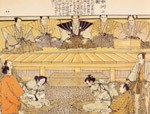 Hojojutsu is the martial art of tying up suspects and criminals using a
rope or cord. They have used this technique in Japan since the 14th century and it
continued until the latter half of 19th century. Currently, in Japan, a
police officer is allowed to use a rope, in addition to handcuffs, as
long as he is sufficiently skilled in this technique.
Hojojutsu is the martial art of tying up suspects and criminals using a
rope or cord. They have used this technique in Japan since the 14th century and it
continued until the latter half of 19th century. Currently, in Japan, a
police officer is allowed to use a rope, in addition to handcuffs, as
long as he is sufficiently skilled in this technique.
Hojojutsu means "art of seizing with help of a rope"; ho (also tori) - to
catch, to seize, to arrest; jo (also nawa) - a rope; jutsu - art. As we see
the second name has the same meaning - torinawa jutsu.
 The main purpose of Hojojutsu was to capture a suspect/enemy/criminal and
to confine him, in such a way, that he would be unable to resist or run
away. Hojojutsu use reached its pinnacle in the feudal historical period
in Japan. At that time, they used it to capture an enemy who had important
information or to detain someone who could later be exchanged for a prisoner
held on the enemy side. Clearly there were various reasons to tie someone
up but one of the main reasons was to have a crime suspect fully restrained
in order to bring him in for trial or questioning.
The main purpose of Hojojutsu was to capture a suspect/enemy/criminal and
to confine him, in such a way, that he would be unable to resist or run
away. Hojojutsu use reached its pinnacle in the feudal historical period
in Japan. At that time, they used it to capture an enemy who had important
information or to detain someone who could later be exchanged for a prisoner
held on the enemy side. Clearly there were various reasons to tie someone
up but one of the main reasons was to have a crime suspect fully restrained
in order to bring him in for trial or questioning.
 There are different types of knots used for tying up people. There is the simple
fastening knot but also the type of knot that, when the individual attempts
to loosen the knot, becomes even tighter. A single captive will be tied up
differently than a few captives and different knots and ropes will be used
in various situations. A cord fastened to a sheath of a Samurai's sword was
often used to tie up a casual captive.
There are different types of knots used for tying up people. There is the simple
fastening knot but also the type of knot that, when the individual attempts
to loosen the knot, becomes even tighter. A single captive will be tied up
differently than a few captives and different knots and ropes will be used
in various situations. A cord fastened to a sheath of a Samurai's sword was
often used to tie up a casual captive.
From a method of teaching
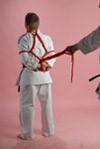 Generally speaking, a man tied up in the usual way, can feel about the ropes
with his hands and can often loosen them enough to get free. Using special
methods, the individual is bound in such a way that they are unable to get
free because when one rope is loosened, the other one become tighter.
Generally speaking, a man tied up in the usual way, can feel about the ropes
with his hands and can often loosen them enough to get free. Using special
methods, the individual is bound in such a way that they are unable to get
free because when one rope is loosened, the other one become tighter.
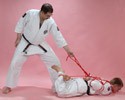 These special methods of limiting movement are not the only way to make
yourself secure against a bound man trying to get free. Another effective
method is to decrease movement or even to completely restrain an individual
using loose loops around their neck. Essentially, they are bound with
loops, around their elbows and wrists, so that any attempt to even move a
hand would lead to the tightening of the loops. In addition, you can bind
the legs in the same way making them completely immobile.
These special methods of limiting movement are not the only way to make
yourself secure against a bound man trying to get free. Another effective
method is to decrease movement or even to completely restrain an individual
using loose loops around their neck. Essentially, they are bound with
loops, around their elbows and wrists, so that any attempt to even move a
hand would lead to the tightening of the loops. In addition, you can bind
the legs in the same way making them completely immobile.
Examples of Hojojutsu techniques
Training
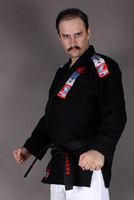 Instructor - Alexander Laskin, ju-jitsu second dan (19 years experience),
Hojojutsu second dan (10 years experience).
Instructor - Alexander Laskin, ju-jitsu second dan (19 years experience),
Hojojutsu second dan (10 years experience).
The training is divided into three stages. Each stage consists of four
two-hour classes. After completing the entire program and successfully
completing the exams, a student may be admitted to confirmation to get
Hojojutsu first dan.
Trainees complete each stage at a separate workshop. Between workshops
they have to practice what they have learned thus working to improve their
skills. At the end of each workshop those who complete the program
successfully may be confirmed to a higher level.
First workshop program
- Hojojutsu history;
- Rules of safety when working with a rope;
- Preparing a rope for work;
- The ready-fastening a short rope around a body;
- Ritual with a rope - in hands and on a body;
- Preparing loops;
- Theory of putting single and double coils in parallel and with crossing;
- Basic variants of cording up limbs, their distinctions - theory and practice;
- Basic knots, fixation of ends of a rope after completing tying;
- Basic variants of the whole tying;
- Physiology of tying hands up from the front and behind, in different states;
- Physiology of tying legs up in the different states;
- Safety when using of a rope for yourself and for an opponent;
- Tying up hands and legs in the states mentioned above by different and more effective ways for one or another state.
Second workshop program
- Techniques of tying with a short rope fastened previously on a body or used from a hank;
- Basic elements of tying with a long rope;
- Principles of fastening a rope around a neck, a forearm, wrists, an ankles;
- Tying up wrists and ankles and fastening a rope around them;
- Techniques of tying with a short rope fastened previously on a body or used from a hank. Opponent is in a control state lying or standing;
- Tying with one hand;
- Attaining rapid rate in tying with a short rope;
- Tying with a long rope technique. Combining basic elements into full way of tying.
Third workshop program
- Principle and expediency of using special limiting moving methods in tying. Tying with a long rope techniques by using those methods;
- Ceremonial tying, tying for escort, tying with the purpose of the complete inactivity;
- The full cycle - from tying with a short rope in a control state to tying with a long rope for escort.
The interval between the first workshop and the second one should not be less than three months and the interval between the second workshop and the third one - not less than half a year.
Short clips on Hojojutsu:
- clip 1
- clip 2
- clip 3
- clip 4
|






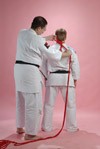
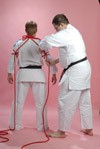
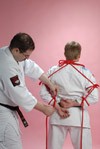
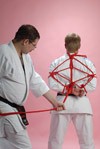
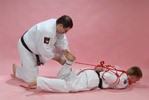
 Instructor - Alexander Laskin, ju-jitsu second dan (19 years experience),
Hojojutsu second dan (10 years experience).
Instructor - Alexander Laskin, ju-jitsu second dan (19 years experience),
Hojojutsu second dan (10 years experience).